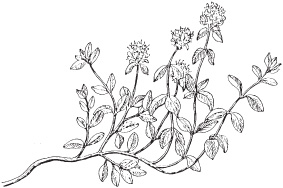Michelle Gillett - Growing & Using Thyme
Here you can read online Michelle Gillett - Growing & Using Thyme full text of the book (entire story) in english for free. Download pdf and epub, get meaning, cover and reviews about this ebook. year: 1998, publisher: Storey Publishing, LLC, genre: Home and family. Description of the work, (preface) as well as reviews are available. Best literature library LitArk.com created for fans of good reading and offers a wide selection of genres:
Romance novel
Science fiction
Adventure
Detective
Science
History
Home and family
Prose
Art
Politics
Computer
Non-fiction
Religion
Business
Children
Humor
Choose a favorite category and find really read worthwhile books. Enjoy immersion in the world of imagination, feel the emotions of the characters or learn something new for yourself, make an fascinating discovery.

- Book:Growing & Using Thyme
- Author:
- Publisher:Storey Publishing, LLC
- Genre:
- Year:1998
- Rating:5 / 5
- Favourites:Add to favourites
- Your mark:
- 100
- 1
- 2
- 3
- 4
- 5
Growing & Using Thyme: summary, description and annotation
We offer to read an annotation, description, summary or preface (depends on what the author of the book "Growing & Using Thyme" wrote himself). If you haven't found the necessary information about the book — write in the comments, we will try to find it.
Growing & Using Thyme — read online for free the complete book (whole text) full work
Below is the text of the book, divided by pages. System saving the place of the last page read, allows you to conveniently read the book "Growing & Using Thyme" online for free, without having to search again every time where you left off. Put a bookmark, and you can go to the page where you finished reading at any time.
Font size:
Interval:
Bookmark:
Michelle Gillett
Breads and Desserts
Metric Conversion Chart
Of all the herbs, thyme is one of the most used, and the one most cooks say they couldnt be without. A native of the Mediterranean, it grows in abundance on hillsides and spices the air with its pungent scent. Warmer climates are said to create stronger flavor in thyme. Honey gathered from Greek wild thyme is world famous. Bees love the pale purple thyme flowers, which you often see growing wild in grassy places and on embankments in the Northeast. Wild thyme, interestingly enough, may have escaped from cultivation from the Shakers. It is often found wild in places near their settlements. Even when thyme is not in flower, it makes itself known with its sharp fragrance when you walk across it or brush against it.
The uses for thyme go back to classical ages, when it first became associated with strength and happiness. Supposedly, the word thyme comes from the Greek thumus, which means courage. During the Middle Ages, women of high rank embroidered sprigs of thyme onto the clothes of knights going off to battle. The Romans introduced thyme to Britain, where among its many medicinal uses it was recommended as a cure for hangovers. An infusion of thyme leaves was just the thing to get rid of a headache after a night of merrymaking!
If you like using natural remedies, you should have thyme in your medicine cabinet as well as in your spice cupboard. Thyme has long been used as a germicide. It derives its medicinal powers from thymol, a powerful antiseptic. In World War I, soldiers used thyme to clean battlefield wounds. Thyme is especially good for intestinal and respiratory ailments, as a mouthwash, and as a wash for cuts.
There are as many as 130 varieties of thyme. Among them, garden thyme is the best known. It is an essential ingredient in the posy of fragrant herb leaves called bouquet garni. In kitchens all over the world, thyme is used for seasoning soups and stews. So many dishes wouldnt be complete without thymes aromatic flavor.
The varieties of thyme provide many different flavors, from lemon to caraway and orange. In France, fields of thyme are grown to be harvested and dried for a blend of culinary herbs called fines herbes.
Dried thyme is an essential ingredient in potpourris and herb pillows and as a flavoring for vinegars. This bulletin will tell you about growing and cultivating several varieties of thyme, and about some of its many uses. Make sure you try the delicious recipes included and thyme products described here!
Thyme is a member of the Labiatae family. The labiate herbs are so called because of their lip-shaped flowers. There are so many varieties of thyme that its impossible to list them all, but you should be familiar with the most common types: carpeting (creeping) thymes, culinary thymes, and decorative thymes. The decorative variegated thymes cannot be grown from seed. Buy plants or ask for a cutting when you visit a friend who has an unusual variety. Some nurseries specialize in herbs and are good for locating less common varieties. When you buy creeping or carpeting thymes, plant them in a rock garden or between paving stones. They like to nestle into warm, dry stones. At the end of this bulletin, youll find a list of sources for thyme plants and seed.
Thyme will grow happily in a sunny window box or container. I like to keep a pot of thyme on my windowsill all winter so I can snip the leaves whenever I need to flavor a sauce or a stew. But thyme, which is a sun lover, will not do so well without lots of sun. It would be interesting to experiment with different flavorings by planting a window box with different varieties of culinary thyme.
Heres a list of some of the best-known varieties:
Garden thyme(Thymus vulgaris), also known as common or English thyme, is a shrubby plant that grows about 12 inches tall and is essential for cooking. It has pale pink blooms and gray leaves that give off a very strong scent. Thymol, the oil distilled from its leaves and flowers, is a powerful antiseptic. I like to dry the leaves of this variety to have on hand to add to dishes. Methods for drying thyme are found on page 7.

Garden thyme
Lemon thyme(Thymus x citriodorus) is a spreading plant, smaller than garden thyme, with dark green leaves and deep pink flowers that bloom in June. The smooth leaves have a nice spicy-lemon smell. Like garden thyme, it is an invaluable ingredient for cooking. There are more than 50 forms of this thyme, but actually only 3 are grown for cooking uses. One has gold-and-green leaves; the other has a thin white edging on green leaves. Lemon thyme has a milder flavor than garden thyme but, because of its strong citrus aroma, it is better in teas than in savory dishes. Its delicious with chicken, in fruit salads, and in breads. Use it in place of grated lemon peel. Both garden and lemon thyme should be cut back at the end of flowering and divided every 2 years.

Lemon thyme
Mother-of-thyme(T. serpyllum), also known as wild thyme(T. praecox subsp. arcticus), is a carpeting plant. One cultivar, Coccineus, has magenta-purple flowers. Another cultivar, Splendens, has pinkish lavender flowers and tastes spicy.Albus has white flowers and tastes a little like anise. These low-growing thymes are not great for cooking but make wonderful, fragrant ground covers.
Caraway thyme(T. herba-barona) tastes like caraway seeds and should be used to flavor vegetable dishes such as turnips, carrots, and cabbage, or used in breads. It is also nice as flavoring for game and meat and combines well with wine and garlic in cooking.

Mother-of-thyme
Azores thyme(T. caespititius) has a strong citrusy-pine smell. It is used as a flavoring. As a substitute for or in combination with lemon thyme, it creates an even stronger citrus flavor. It is grown from seed and has -inch-long slightly sticky, slender leaves, long woolly stems, and pink, lilac, or white flowers that bloom in late spring to summer. It grows in mounds and is perfect for rock gardens.

Caraway thyme
As long as you dont live in a swamp, thyme is one of the easiest herbs to grow, something that might account for its popularity as a garden and culinary herb. The best place to plant thyme is in a sunny, dry spot that mimics its Mediterranean origins. Any site with poor stony soil on a slope is ideal for thyme, which makes it one of the few plants that will thrive in an otherwise bare spot in your yard. In ordinary gardens, thyme may need a raised bed to keep it happy.
Thyme is a spreading, evergreen perennial that can grow up to 18 inches tall. It can be cut into a hedge or used as a border planting. Creeping varieties make nice scented ground covers, and can even be used as a lawn substitute in low-traffic areas of your yard. Thyme can weather a drought but might not survive in extreme cold unless it is sheltered and dry. Almost all thymes are hardy to Zone 4, but poor drainage during the winter may kill them. If you live in a very cold climate, you might want to bring your thyme plants indoors for the winter.
Font size:
Interval:
Bookmark:
Similar books «Growing & Using Thyme»
Look at similar books to Growing & Using Thyme. We have selected literature similar in name and meaning in the hope of providing readers with more options to find new, interesting, not yet read works.
Discussion, reviews of the book Growing & Using Thyme and just readers' own opinions. Leave your comments, write what you think about the work, its meaning or the main characters. Specify what exactly you liked and what you didn't like, and why you think so.




